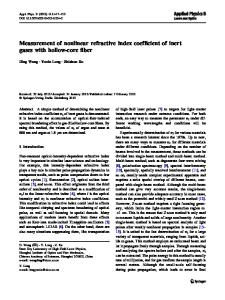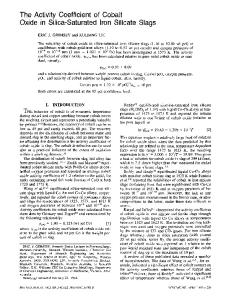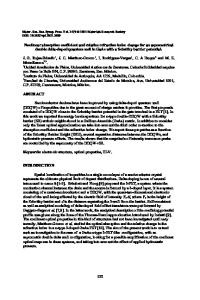Determination of refractive index and absorption coefficient of iron- oxide-bearing slags
- PDF / 1,204,961 Bytes
- 7 Pages / 603.28 x 783.28 pts Page_size
- 92 Downloads / 542 Views
I.
INTRODUCTION
THE effective use of energy is more important in newer iron- and steelmaking processes, such as smelting reduction. For this purpose, the analysis of heat-transfer processes in slags is a key subject, In the analysis, the heat transfer by radiation should not be negligible, because radiation conduction can be the predominant mode of heat transfer at high temperatures where the metallurgical operations are carried out. If a slag phase is optically thick and if a temperature gradient is small, the radiation heat flux, qr, in the slag phase can be calculated by the equation qr = - 16n2 o ' T 3 V T / 3 c~ [ 1] Here, n and a are the refractive index and optical absorption coefficient of slag, respectively, cr the StefanBoltzmarm constant, and T absolute temperature. In order to conduct precise calculations, it is necessary to have reliable data of the refractive index and absorption coefficient of slags, especially with high iron-oxide content. Refractive index has been reported for many transparent silicate glasses, m Iwamoto e t al. I2,31 have also measured the refractive index of binary and ternary transparent silicate glasses at room temperature, with respect to basicity. They have shown that the ionic refraction of oxygen calculated from refractive index can be used as a basicity of silicate glasses and proposed the concept of refraction basicity which is defined by the ratio of ionic refraction of oxygen in silicate glass to that in silica glass. However, there are no previous reports of measurements of refractive index for opaque slags containing iron oxide. On the contrary, absorption coefficients have been measured for silicates containing iron oxide in the waveMASAHIRO SUSA, Research Associate, FUTAO LI, Graduate Student, and KAZUHIRO NAGATA, Associate Professor, are with the Department of Metallurgical Engineering, Tokyo Institute of Technology, Tokyo 152, Japan. Manuscript submitted December 14, 1991. METALLURGICAL TRANSACTIONS B
length range of visible to near-infrared rays at room temperature and/or high temperaturesJ 4-s~ These silicate samples contained iron oxide of below 1 mass pct, because most of these studies were carried out in relation to the ligand field theory. On the other hand, the absorption coefficients of slags with high iron-oxide content have been measured at room temperature by Fine e t al. I91 They used two samples which contained 7.1 and 14.2 mass pct FeO. But the dependences of absorption coefficient on iron-oxide concentration and basicity were not systematically determined. Meanwhile, Ito and Goto tsl have experimentally determined the dependences of absorption coefficient of slags with Fe203 of below 1 mol pct on basicity and Fe203 concentration and discussed the mechanism for optical absorption of the slags in detail. They have pointed out that the optical absorption of the slags in the wavelength range of visible to near-infrared rays is predominantly assigned to the ligand field of Fe 2+ and the transition of electron from 02. to Fe 3+ , i . e . , the charge t
Data Loading...










